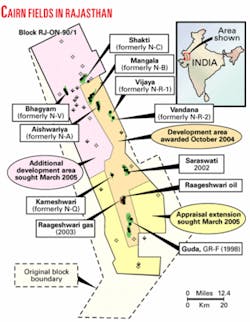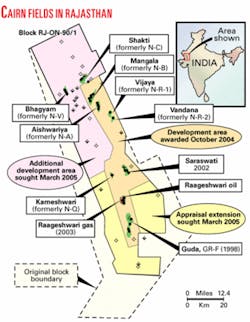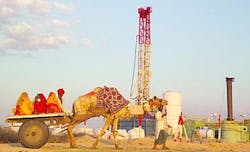Extensive exploratory and appraisal drilling by Cairn Energy indicates the Barmer Basin, Rajasthan, is an emerging oil province, underlain by a tertiary rift system.
The major focus of Edinburgh’s Cairn Energy PLC over the last few months has been in Rajasthan province, northern India. The company has been exploring the 6,688-sq km (5,000-acre) Rajasthan Block RJ/ON-90/1, near the border with Pakistan. This block contains the Mangala, Bhagyam (formerly N-V) and Aishwariya (formerly N-A) fields in the north and the Raageshwari, Saraswati, and Guda fields in the south.
Cairn Energy has an active drilling program in Rajasthan and has drilled 77 wells through Apr. 1, 2005, including 51 exploration and appraisal wells in 2004, and 10 wells in 2005.
Cairn said drilling shallow wells with land rigs has been cost-effective. The company has discovered 11 fields in Rajasthan, according to preliminary 2004 results issued last month by the company (Fig. 1). The smaller southern fields will be developed separately from the three major northern fields.
Cairn has secured an extensive development area of 1,858 sq km within the block, awarded in October 2004, with rights until 2020 and options for further extensions. The area is equal in size to 8 North Sea blocks. Cairn has applied for an extension of the development area to include the Bhagyam and Shakti discoveries, which would increase the area to 4,743 sq km (21 North Sea blocks).
History
Cairn Energy India Pty. Ltd. (formerly Command Petroleum India Pty. Ltd.; acquired in 1995), once an Australian company and now British, was the first foreign company in the history of modern India to gain equity in and operate a major oil and gas field. Cairn took over Ravva field operations in February 1995, although state Oil & Natural Gas Corp. Ltd. (ONGC) maintains a 40% stake in the project. Raava’s gross production was 70,000 boe/d in 2004. Cairn plans additional infill wells in 2005 to maintain plateau production.
Cairn also produces gas and oil in India from Gujarat, south of Rajasthan (gross 16,000 boe/d) and operates the Sangu gas field in Bangladesh (gross 23,000 boe/d). In 2004, Cairn spent 81.8% of its total capital expense budget in India (£102.2 million) and 15.5% in Bangladesh (£19.3 million). In 2005, the company plans to spend 81% of its capital expenditure budget in India (£121.2 million) and 16% in Bangladesh (£24.2 million).
The Barmer basin in Rajasthan has more than 2 billion bbl of oil in place, of which 1.64 billion is contained in three fields: Mangala, Bhagyam, and Aishwariya. According to Dallas-based independent auditors DeGolyer and MacNaughton, 380-700 million bbl is recoverable from the three fields, depending on enhanced oil recovery techniques.
Geology
In a paper published in April, Sisodia et al. describe the Barmer basin as a narrow, north-south trending graben containing middle Jurassic to lower Eocene age sediments.1 The syn-rift sediments are the sands and conglomerates of the Barmer Hill formation deposited in alluvial fans, underlying the sand, mud, and phosphorite of the Fatehgarh formation (reservoir).
According to Cairn’s Pierre Eliet, who will present a paper on the company’s exploration of the Barmer basin at the AAPG Annual Convention in Calgary in June, Cairn and Royal Dutch/Shell Group drilled early wells in the Barmer basin and found good source, trap, and migration pathways.
Cairn’s discovery of stacked, continuous, Paleocene fluvial sand systems forming the Mangala field reservoir provides the missing primary play element.2
Northern fields
Cairn discovered oil in the Mangala field, in the Thar Desert, in January 2004. The Mangala-1 discovery well was the 16th well drilled by Cairn in the basin. The company then drilled five appraisal wells, March-July 2004.
The Aishwariya field discovery well was drilled in March 2004. Appraisal wells were drilled April-September 2004.
A 3D survey across the Mangala and Aishwariya fields was acquired May-December 2004, covering 450 sq km and is currently being interpreted.
Cairn proposes to drill the northern fields with densely spaced high-angle wells, followed by secondary recovery using water floods, and enhanced/tertiary oil recovery techniques.
Cairn received formal approval from the government of India for a declaration of commerciality at Mangala, and ONGC took up its option to acquire a 30% participating interest in both the Mangala and Aishwariya discoveries in January 2005.
In the same month, the Indian government awarded Cairn an 856 sq km extension area based on the N-V (Bhagyam) oil discovery made in August 2004. Appraisal wells were drilled January-April 2005, and at least two more wells are planned. The field was officially named in a ministerial ceremony on Apr. 4.
Cairn has been negotiating appraisal extensions for the northern area, as the existing exploration agreement ends May 15, 2005. This area includes the Bhagyam field, 18 km west of Mangala, estimated by Cairn to contain 250-350 million bbl of oil. The company wants to drill at least four wells across the northwest extension area in May-July 2005, if the extension is granted.
Cairn also said it would submit a phased field-development plan on behalf of the joint venture to the Indian government in May. First production from the Mangala field will be yearend 2007, followed by production start up at Bhagyam and Aishwariya. Target peak production is 100-110,000 bo/d from Mangala, 15-30,000 bo/d from Bhagyan, and 5-15,000 bo/d from Aishwariya.
Three other northern oil fields, Shakti (formerly N-C, discovered April 2004), Vijaya (formerly NR-1, discovered September 2004), and Vandana (formerly NR-2, discovered November 2004) remain to be evaluated. Two appraisal wells were drilled at Shakti September-December 2004 and flow-tested oil.
Southern fields
Cairn has drilled several wells in the Guda field and GR-F extension, discovering oil in the Dharvi Dungar and Thumbli formations. The company plans to drill eight more appraisal wells later in 2005 to delineate field size.
The Saraswati field was discovered in late 2001 and two appraisal wells were drilled in 2003. The fourth well, drilled in 2004, tested the crest of the structure and fracture stimulation has increased flow rates.
The Raageshwari field was discovered in early 2003, and three appraisal wells were drilled in 2003-04. In addition to deep gas produced from the Fatehgarh formation, the field also produces from a nonconventional volcanic reservoir. Two more wells drilled in first-quarter 2005 evaluated the deep gas potential, and two additional wells are planned for later in the year.
Cairn is engaged in stimulation studies to understand potential recovery factors. The company says that Raageshwari wells may require fracture stimulation before they complete reserve assessments.
NELP V
Twelve onshore blocks are among the 20 blocks being offered by India in the fifth new exploration licensing policy round, announced in January 2005. Acreage awarded in NELP rounds since 1999 carries no back-in right for ONGC. Bidding is open until May 31.
Two of the onshore blocks on offer are in Rajasthan: RJ-ONN-2003/1 (1,335 sq km) and RJ-ONN-2003/2 (13,195 sq km). Neither have been drilled.
According to the NELP-V technical and general information booklet, 99 exploratory wells have been drilled in the 1.26 million sq km Rajasthan basin.
The Directorate General of Hydrocarbons, under the Ministry of Petroleum & Natural Gas, will award the blocks by July 15, 2005.✦
References
1. Sisodia, M.S., Singh, U.K., Lashkari, G., et al. “Mineralogy and trace element chemistry of the Siliceous Earth of Barmer basin, Rajasthan: Evidence for a volcanic origin.” J. Earth Syst., Vol. 114, No. 2, April 2005, pp. 111-124.
2. Eliet, P., Heaton, R., and Watts, M., “The Barmer Basin, Rajasthan, India-the Ingredients Which Led to Exploration Success.” AAPG Annual Convention, Calgary, June 19-22, 2005.



